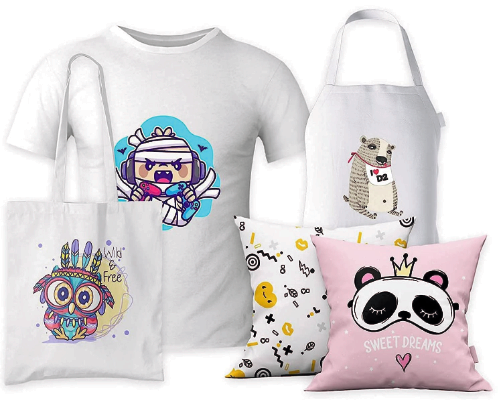Sublimation printing | Technology and application
Sublimation printing belongs to the family of transfer printing processes and is one of the most popular printing processes ever.When it comes to producing creative photo items, individual gifts or promotional items, sublimation printing is the first choice.
You will find out how the printing process works and what advantages and disadvantages it has in the further course of this article.
What is sublimation printing?
Sublimation is a physical process in which the dye of the sublimation ink is applied to the printing material by heating
transferred and evaporated (sublimated) into the material.
For this process to work, synthetic polyester fabrics or polymer-coated materials are necessary.
Blended fabrics are also possible, provided the polyester content in the fabric is sufficiently high (approx. 60-70%).
In any case, it is essential to carry out your own tests.
A variety of different materials can be printed using sublimation printing, such as glass, ceramics, plastic, wood, metals, T-shirts and other textiles.
The most popular products that can be printed with sublimation inks are undoubtedly T-shirts and coffee mugs.
Other popular items can be found in the following list: Mugs, Glasses and Cups, Bottles, Phone Cases, Tiles, T-Shirts, Sports Trickots, Plates, Pendants,
Metal plates/signs, fabric bags, umbrellas, bed linen and towels, lanyards, puzzles, mouse pads, and much more
How does sublimation printing work?
We describe sublimation printing using the example of a small-format printer, which is often used in the area of advertising material production.
In large-format, industrial sublimation printing, the manufacturing process may vary.
- Using an inkjet printer (sublimation printer) filled with sublimation inks, the desired print motif is printed sideways on special sublimation paper.
- The printed sublimation paper is then placed on the printing material and fixed.
- With the help of a thermal transfer press, the transfer paper and the printing material are heated to 200 degrees, depending on the material used.
When heated, the dyes in the sublimation ink are converted into a gaseous state and penetrate into the fabric or the polymer layer of the printing material.
In addition, the transfer press applies high pressure to support the transfer process.
What is needed for sublimation printing?
- Sublimation printer
- Sublimation ink
- Sublimation paper
- Suitable pre-coated printing materials, T-shirts, fabrics
- Thermal transfer press, calender, hot air oven, cup press
Advantages and disadvantages of sublimation printing?
The following list shows possible advantages and disadvantages of sublimation printing.
Advantages:
- Materials can be printed in high resolution and quality (photorealistic printing).
- Numerous different materials can be used. Since the printing ink passes into the fiber, sublimation printing is not noticeable and has a pleasant feel.
- Cost-effective compared to other printing methods
- Solvent-free inks, more environmentally friendly than other printing methods
- The print is UV-resistant and has a high
- Printing small runs and individual items is also possible.
Disadvantages:
- Printing materials must be resistant to heat and high temperatures. This means that not every material is suitable for sublimation printing.
- Textiles to be printed must consist of as high a proportion as possible of synthetic materials. Cotton or dark surfaces are not suitable at all or are less suitable for this


